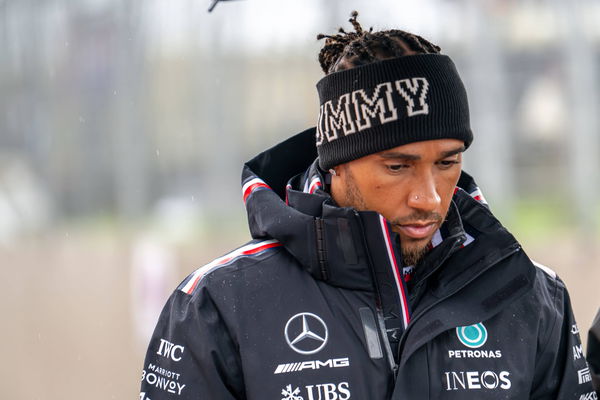
via Imago
ZANDVOORT, NETHERLANDS. Lewis Hamilton, racing for the Mercedes. F1 team during the. 2023 Formula 1 Dutch Grand Prix at the Circuit. Zandvoort in Zandvoort, Netherlands.

via Imago
ZANDVOORT, NETHERLANDS. Lewis Hamilton, racing for the Mercedes. F1 team during the. 2023 Formula 1 Dutch Grand Prix at the Circuit. Zandvoort in Zandvoort, Netherlands.
In a wave of post-race drama at the US Grand Prix in Austin, Mercedes’ Maestro Lewis Hamilton is sounding the alarm over what he sees as systemic inconsistencies within Formula 1’s regulatory system. Hamilton was disqualified due to a worn floor plate, a fate similarly met by Ferrari‘s Charles Leclerc. Yet, it’s the underlying implications of the decision that Hamilton finds most troubling.
Hamilton expressed deep frustrations, hinting at the potential bias of the FIA. He hinted at the selectivity of the vehicles tested post-race. Out of the cars that finished the race, only four underwent a comprehensive check, which, according to Hamilton, implies a potential oversight, or worse, selective scrutiny.
ADVERTISEMENT
Article continues below this ad
A “devastated” Lewis Hamilton urges for overhauled F1 regulations
Hoping for a revision in the current protocol, Hamilton called for a fairer structure in F1. He feels that certain regulations, especially those around Parc Ferme, are begging for an overhaul. Mercedes made adjustments to the floor plate post the initial training session when it was intact. He attributes the damage, in part, to the uneven nature of the track. Some cars, Hamilton observes, handle the undulating terrain better than others.
Lewis Hamilton was asked about the disqualification at COTA, and said: “I heard from various sources that many other cars were also illegal.”
“But they weren’t tested, so they got away with it,” he said, who is therefore calling for a “better structure” in post-race testing.
— Junaid #JB17 (@JunaidSamodien_) October 26, 2023
However, amidst the disappointment, Hamilton’s spirit remains unbroken. Reflecting on the race day, he said, “I was devastated because it was such a great day and such a great race.” He added,
“I heard from several sources that there were a lot of other cars that were illegal and they were not tested so they got away with it.”
“I have been racing here for 16 years and there have been many other scenarios like this where some people have got away with it, and some have been unlucky and been tested.
Despite the setback, Hamilton was firm in defending the performance of his Mercedes.
READ MORE: Can Lewis Hamilton Avenge Max Verstappen & Overcome the 2022 Mexican GP Embarrassment?
The floor plate issue, being off by a mere 0.05 millimeters, was not the root cause underlying the issues he faced. The gravity of the disqualification, given the minor nature of the discrepancy, was a bitter pill to swallow, especially as news of it was delivered just as he was transitioning from a press conference. As Formula 1 moves forward, fans and teams alike will be watching closely to see if Hamilton’s calls for more transparency and fairness in the sport will be heeded. But in response to growing speculation around its post-race scrutiny methods, the FIA has sought to shed light on the process and address concerns.
FIA clears the air on post-race scrutinizing
The FIA has been quick to clarify, stating, “Random post-race checks have been a part of their procedure for many decades.” These random checks serve to maintain the integrity of the sport, as teams never know in advance which parts of which cars will be examined beyond the standard weekend checks. While Hamilton and Leclerc’s cars were under the scanner, the cars of Max Verstappen and Lando Norris were also randomly checked, with both being found compliant. Yet, the 50% failure rate in this sample raised eyebrows. Sky F1’s Martin Brundle and others questioned if such a high breach rate shouldn’t trigger a review of all race-finishing cars.
Hamilton and Leclerc disqualified for plank wear irregularities on their cars following an inspection by an FIA technical team
Full story ⤵️#F1 #USGP https://t.co/w1yR2EpvAC
— Formula 1 (@F1) October 23, 2023
To this, the FIA mentioned a major constraint: time. The window between the end of a Grand Prix and the transportation of cars to the next race is brief. While the scrutinizing team conducts a myriad of checks, it’s logistically challenging to examine every parameter of every car, especially during back-to-back race weekends. The FIA stated, “This is why the random selection process is invaluable. Teams know they could be chosen and that non-compliance risks are high.”
Concluding their statement, the FIA reassured fans, saying that it has continually refined the process to ensure meticulous monitoring of the technologically advanced F1 cars. The clarity provided by the FIA is an important step towards ensuring transparency in the sport and putting to rest any fanciful theories around the integrity of race outcomes.
WATCH THIS STORY | Lewis Hamilton’s Car Collection
ADVERTISEMENT
Article continues below this ad
ADVERTISEMENT
Article continues below this ad
ADVERTISEMENT
ADVERTISEMENT
ADVERTISEMENT
ADVERTISEMENT

